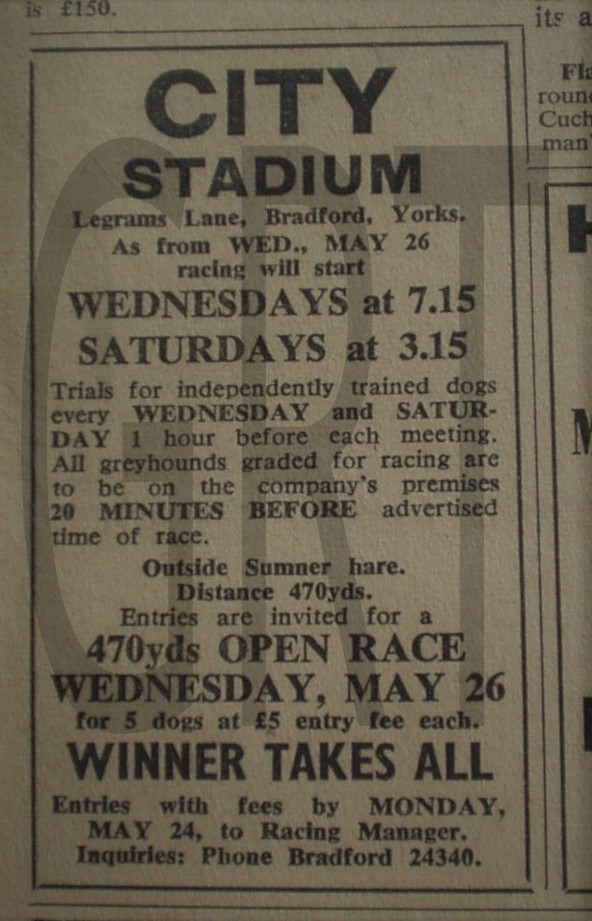City Stadium, Legrams Lane, Lister Hills, Bradford, West Yorkshire.
POSTCODE———————————–BD7 NQ
LOCATED————————————-Along Greyhound Way just off Legrams Lane situated about one mile west of Bradford city centre.
ORIGINAL SITE——————————Undeveloped land
DATE CONSTRUCTED———————Early 1930’s
DATE VENUE OPENED——————–August 1932
Meaning other sports may have taken place prior to the arrival of Greyhound Racing.
FIRST MEETING—————————–Monday 15th August 1932.
Greyhound Racing only.
LICENSED OR INDEPENDENT———–Independent from 1935 onwards.
All venues covered would have to be licensed with the government, licensed suggested in this section would refer to tracks operating under NGRC Rules.
INSIDE OR OUTSIDE HARE TYPE——-Outside Sumner.
Please note that the Electric Hare suggested is only a guidance and would have been in operation for a certain amount of time at this venue. Although it is not necessarily guaranteed that it was operational all the time, as other types of lure may have been used and updated as time progressed.
DISTANCES———————————–426 and 470 yards.
Please note that most racing venues distances had become varied throughout the years, the ones given above were at once point set and offers only a guidance to the track size.
CIRCUMFERENCE—————————Dont know
Please note that alterations at most racing venues throughout its existence would see that the circumference of the track would vary, the one shown above offers only a guidance to the track size.
BIG RACE NAMES—————————None available.
-STADIUM SHARED WITH—————–A cycling track surrounded the greyhound track.
LAST MEETING——————————-October 30th 1965.
Greyhound Racing only.
STADIUM CLOSURE DATE—————-1965
Meaning other sports may have taken place after Greyhound Racing had ceased.
STADIUM DEMOLITION——————–Late 1960’s.
BUILT ON SITE——————————–Federal Mogul Industries. on Greyhound Drive on Legrams Lane.
In some cases, structure’s that originally covered the venue after the stadium had been demolished, may have been themselves demolished too, so the one described is more likely to be the one which now presently covers the site.
EVIDENCE LEFT TODAY——————–Nothing known of.
FURTHER COMMENTS———————In 1958 the stadium became host to a well known film “Room at the Top” featuring top actor at the time Laurence Harvey.









The West Yorkshire city of Bradford adds itself to the list of cities that once hosted Greyhound Racing at more than one venue within its boundaries. This chapter describes its latter one which became known as The City Greyhound Stadium, a venue situated in the district of Lister Hills, one mile west of Bradford’s city centre. Construction began in the early 1930’s on grazing land that lay on an incline, which did eventually contribute to the track having a definitive slope along its finishing and back straights.
Advertised as ”The Ascot Of The North”, the City Stadium staged its first meeting on the 15th of August 1932, with a crowd of over 4,000 witnessing an event that would be run under NGRC rules. All of the racing greyhounds were provided by the greyhound company, with the resident hounds kennelled within the stadium’s boundaries. But this changed once the venue had become established, as due to shortages of entrants, privately owned hounds were invited to race there, with the understanding that they too must also be kennelled at the stadium. On the racing side of things, the hounds chased an outside Sumner type hare, with racing distances set over 426 and 470 yards, with the lesser distance calculated due to the traps operating from a shoot set back just off the bend.
Yet in 1935 a change in governed bodies witnessed The City Stadium switching its operation to act independently, and that is how it remained throughout its following existence. In 1951, a cycle track was constructed on the infield of the greyhound track, although it was a rough surface originally, the track was relayed to a much-improved standard during 1954.
Probably the City Stadium’s most famous five minutes came in 1958, when the venue played host to a feature film called “Room at the Top”, which starred one of the top male actors at the time, Laurence Harvey. The decline of the stadium began during 1961, with firstly the governments’ introduction of new betting legislation, which in turn had seen crowds dwindle, yet a large fire during the Summer of 1963, became the main instigator to its eventual closure. Although the fire totally destroyed some wooden structures, it also badly damaged part of the main stand, yet racing did continue once temporary repairs had been done. The blaze had caused an estimated £50,000 worth of damage, a figure way beyond the coffers of the greyhound company meant that the venue would never be rebuilt.
It had come as no surprise when the shabby City Stadium staged its final meeting on the 30th of October 1965, leaving the site just to decay over the following years before it was eventually demolished during the late 1960’s. The site was eventually purchased by developers who acquired the site to build an industrial estate.
Today the site is covered by Federal Mogul, a large industrial works situated on Greyhound Drive which lies just off Legrams Road. Nothing remains of the venue today, even a railway bridge that once accessed the venue has gone along with the railway cutting that ran beneath has been filled in and acts now as nothing more than waste ground.

Recent Comments